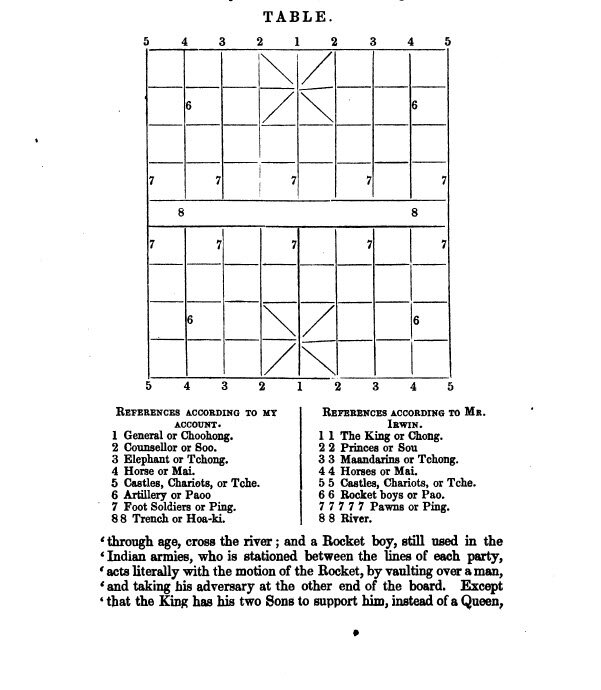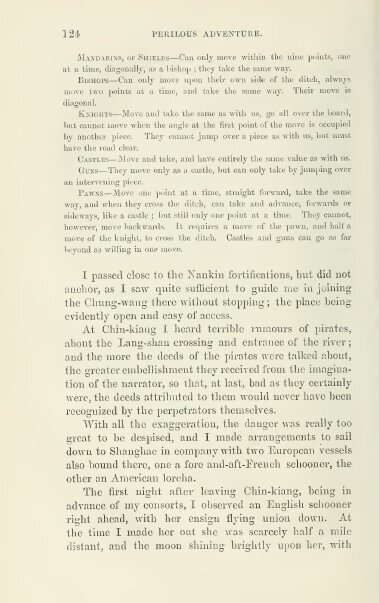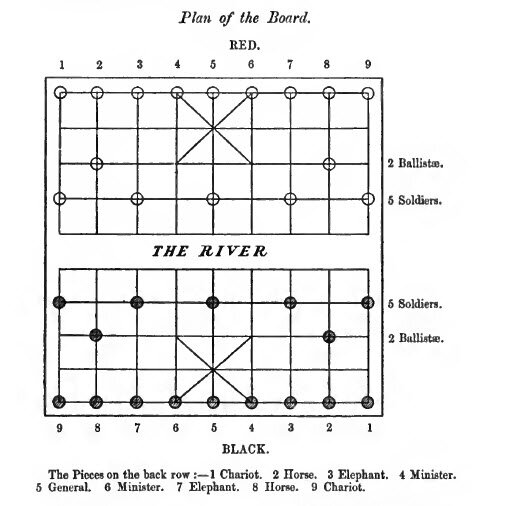Early translations of the Xiangqi (Chinese Chess) Pieces Part 1
Author: Jim Png from XqInEnglish
Xiangqi (Chinese Chess) was mentioned by Western scholars as early as 1583-1610AD by Matteo Ricci, who went to China as part of evangelism. More Western scholars, travelers, explorers, merchants, politicians, envoys, et cetera have mentioned Xiangqi in their works.
Faced with a new object, these early writers used their understanding and interpretations to translate the game in their writings. While some of the translations were entirely accurate, there were other more interesting and sometimes hilarious translations.
The author has spent years tracking down possible mention of Xiangqi in the early literature, and the following is a summary of how the early Western scholars translated the pieces.
The article has been divided into two parts as the amount of material that the author has found was slightly overwhelming.
Why understanding the early translations is important
1583-1610AD Matteo Ricci's translations
1613-1636AD Alvaro Semedo and his travels
1687AD Shen Fuzong and Thomas Hyde
1765 AD Robert Lambe's translations
1793AD Eyles Irwin description of the pieces and 1799AD Hiram Cox's translations
1866 Augustus Lindley's description of Xiangqi
1870AD K. Himly discussed Xiangqi
1879AD JD Vaughan's detailed description of Xiangqi
Why understanding the early translations is important
Over the past few decades, there have been many different translations of the Xiangqi pieces as part of efforts by various early promoters of the game. The most commonly translated language is English. Unfortunately, the translations were not the same and have caused some difficulty in spreading the game. To the author, who has been promoting Xiangqi since 2011, there are still many different translations that can confuse the non-native Chinese speaker. It must be worse for people who do not know Chinese or Xiangqi.
1583-1610AD Matteo Ricci's translations
Matteo Ricci (1552-1610AD, aka 利玛窦(Lì Mǎ Dòu)) wrote De Christiana Expeditione apvd Sinas, which was later translated into Latin by Nicholas Trigault (1577-1628AD). It was a collection of Ricci's travels as a Jesuit priest into China. The Chinese name for the book would be 《利玛窦中国札记》(Lì Mǎ Dòu Zhōng Guó Zhá Jì). The author found an English version of the original work published in 1953 called China in the Sixteenth Century: The Journals of Matthew Ricci: 1583-1610. The translator was Gallagher, Louis J, and the book was published in 1953.
“ The method of playing, however, is decidedly different. In their game, the kingpiece does not go beyond the four spaces contiguous to his original position and neither do the pieces corresponding to our bishops. There is no queen piece. They have two rather novel pieces, which they call gunpowder bowls or cartridges, which are placed before the knights and behind two pawns placed one space in advance of the regular line of pawns. This powder-bowl unit moves in about the same manner as our Castle but does not seek to disturb the opposing King unless a piece belonging to the opposition is between it and the King in question. The kingpiece has three ways of avoiding a checkmate; by moving aside into the next space, by taking the piece holding him in check, or by sacrificing a protecting piece. “
The author has not been able to find the original writings and suspect that the translations may have been not only once. There are apparent inadequacies as not all the pieces were mentioned, and the special rule of the kings not being to face each other was not mentioned, et cetera. However, this is perhaps the earliest description of Xiangqi and its pieces. (1)
1613-1636AD Alvaro Semedo and his travels
Alvaro Semedo (c. 1585-1658AD) was another Jesuit priest who travelled to China as a missionary. Like his predecessor, Matteo Ricci, he recorded his travels in China in a book called The History of that great and renowned monarchy of China, which was translated into English and published in 1655.
Semedo was not as lucky as Ricci for there was an anti-Christian campaign and he was forced to change his Chinese name from Xie Wulu (谢务禄 xiè wù lù) to Zeng Dezhao (曾德昭 zēng dé zhāo).
The author has managed to find a translation of his text, and Semedo used similar translations that Ricci used. (2)
1687AD Shen Fuzong and Thomas Hyde
Perhaps the earliest and most 'formal' introduction of Xiangqi to the West was the introduction done by Shen Fuzong, a Chinese man who travelled from China to Europe. He taught Thomas Hyde about the game, and Thomas Hyde wrote his groundbreaking work in Adversaria Chinensia.
There is much more to Thomas Hyde and Xiangqi, but we will focus on the translations that he used for this article.
Thomas Hyde demonstrated his linguistic capabilities with by explaining some Chinese terms.
For Xiangqi, he would be the first to mention the difference in dialects and mandarin, and he was able to point out some interesting differences. Hyde also preferred to use the romanized names of the pieces instead of translating them directly. (3) (4) (5)
1765 AD Robert Lambe's translations
Robert Lambe wrote a short book with a very long title called "History of Chess, Together with Short and Plain Instructions, By which any one may easily play at It without the Help of a Teacher" published in 1719AD. Other than several VERY QUESTIONABLE statements on the history of Xiangqi, which is beyond the scope of this article, Robert Lambe came up with several interesting translations of the Xiangqi pieces. (6 pp. 75-91)
There were also some mistakes in which the pieces were described. For example, he mentioned that the 'knight could not pass the river.' (6 p. 80)
The Xiangqi pieces, according to Lambe, were: the general, the lieutenant-generals, the elephants, the knights, the chariots, the cannons, and the pawn.
1793AD Eyles Irwin description of the pieces and 1799AD Hiram Cox's translations
In 1793AD, Eyles Irwin wrote about his encounters with Xiangqi when he travelled to China. A young mandarin brought him a set and proceeded to introduce him to the game. Eyles Irwin was also the first person in the West to openly voice the hypothesis that chess was first invented in China by General Han Xin. (7)
Eyles Irwin's hypothesis had much impact on later historians and western chess lovers alike. It was quoted in several sources and later historians who refuted his hypotheses. Other people believed his ideas. Dr. Ercole Dal Rio copied his entire passage in The Incomparable Game of Chess. (8)
A few years later, in 1799AD, Captain Hiram Cox, stationed in Burma, wrote a lengthy article pushing forward his hypothesis about the origins of chess. In his article, he also denounced the names and introductions that Eyles Irwin had. (9)
The author has combined these two introductions under one section for a few reasons.
First of all, neither men were wrong about their descriptions of the pieces. The pronunciations varied because they used different Chinese dialects to read the words! This concept may be incomprehensible, but the author has found a light-hearted video to explain why.
Second of all, as in International Chess, there can be more than one way of naming objects, as evidenced by the name of Xiangqi and Chinese chess et cetera.
The diagram below is from Hiram Cox's article, which compares his recommendations and Irwin's translations.
1866 Augustus Lindley's description of Xiangqi
Augustus Frederick Lindley (1840-1873) was in China during the Taiping Rebellion. In 1866, he published a two-volume work called Ti-ping tien-kwoh: The History of the Ti-Ping Revolution, Including a Narrative of the Author's Personal Adventures. The book has been translated into Chinese and is known as《太平天国革命亲历记》 (Tài píng Tiān guó gé mìng qīn lì jì).
Lindley described Xiangqi in Chapter Five of Volume 1, saying that he learnt the game when traveling on a schooner, whereby several fellow passengers to 'Shanghae' taught him how to play. (10 pp. 123-124)
Lindley translated the pieces as King, Mandarin/Shield (for the Advisor), Bishop, Knight, castles (for Chariot), guns (for Cannon), and pawns.
1870AD K. Himly discussed Xiangqi
German historian K. Himly produced one of the most detailed passages on Xiangqi, examining the history of the game in detail. He followed in the footsteps of his predecessors and tried to approach the origins of the game by studying the various passages. As for the names of the pieces, he attempted romanization of the terms of the pieces. It was done as a comparison of similar chess pieces from various chess entities. Himly gave the Xiangqi pieces as ping (for pawn), chiangshuai (for King), shi (for Advisor), Hsiang (for Elephant), ma (for horse), chu (for Chariot), and p'ao (for Cannon). (11)
1876AD Mollendorf
There was a German introduction to Xiangqi by Mollendorf in 1876AD.
The author does not know German and could make out some of the Chinese and English words given in the article. It appeared that General was used for King, Minister for Advisor, elephant/hsiang for the Elephant, ma for the horse, wagon for the Chariot, and p'ao/ballista for the Cannon.
As the author cannot be sure of the contents and does not trust Google translate, the names given will not be written in the tables.
1879AD JD Vaughan's detailed description of Xiangqi
Jonas Daniel Vaughan (1825-1891AD) lived in Malaya for nearly 40 years. He was a policeman who later became a practicing lawyer and was the police superintendent in Penang in the 1850s. He wrote a short book called The Manners and Customs of the Chinese of the Straits Settlements which was published in 1879. Vaughan went and stayed in Singapore in 1856. (12)
On the topic of Xiangqi, JD Vaughan wrote:
Chinese Chess
"The game is played upon an oblong board marked out into sixty four divisions; there are two sets of pieces of opposite colours, sixteen men each, and of various powers. These sets of men are arranged opposite to each other, and attack, defend, and capture like hostile armies. A river is supposed to separate the two armies having thirty two squares on each side. The accompanying diagram will best explain the name and place of each man at the commencement of the game. These moves may be briefly described as follow's: The soldiers or pawns advance along the line they are placed upon until they cross the river into the enemy's board, when the move like our Castle in every direction along the lines a single square at a time; and capture pieces in their way in straight lines.
A cannon like our Castle moves any number of squares forwards, backwards, or sideways but cannot capture a piece if another piece intervenes. This piece may cross the river. The Elephant like our Bishop moves diagonally, two squares at a time and is confined to the sixteen squares on his side of the board, and may not cross the river, or to the side of his fellow Elephant. The Horse like our Knight moves the square forward or backward, and one diagonally, but cannot capture if a piece stands on the angle when he moves diagonally. He may cross the river. The Carriage or Castle moves exactly like our castles, any number of squares backwards and forwards or sideways but not diagonally, and may cross the river.
The Captain or King and Scholars or Councillors are confined to the four squares marked with diagonal lines at the head of the board which may be called the citadel or fort. The Captain moves only one square at a time in any direction along the lines in his citadel. He cannot be taken; and when attacked must interpose one of his pieces or move out of check, unless the checking piece can be captured. When there is no means of rescuing the Captain, the game is over.
The scholars move along the diagonal lines within the citadel. The pieces that may cross the river into the enemy's board are the soldiers, cannons, horses and carriages; and it must be observed that the pieces move along the lines and always stand where the lines cross each other and are never placed on the squares as we place them at chess or draughts. The writer was taught the Chinese game some years ago and played it with Chinese but found it uninteresting. It requires little or no skill." (12 pp. 48-49)
There was also a very nice hand drawn picture of a Xiangqi board, with the pieces marked. The author had asked for permission to print the photo from the Singaporean National Library in the past , but it seemed that processing the picture and the price was way out of the author's means.
1885AD H.F.W Holt and Xiangqi
H.F.W. Holt published an article called Notes on the Chinese Game of Chess in the Royal Asiatic Journal of Great Britain and Ireland back in 1885. His passage was yet another attempt at discovering the origins of chess and Xiangqi.
The names of the words and various ancient Chinese passages described by Himly. Holt was also the first to mention the differences in the characters between Red and Black pieces.
In his article, there were several names which he used to explain and translate. Holt wrote:
“The General stands on the centre or fifth point, supported on either hand by a minister occupying the fourth and sixth points respectively. On the third and seventh points are the elephants, next to them the horses, and on the outside ones the chariots. The four squares in front of the general and his two ministers, giving nine playing-points, are crossed diagonally by two lines, and the movements of these three pieces are confined to this limited space. The next row is vacant, and on the third points of the second and eighth lines stand the two pieces called P'ao, erroneously called cannons, but which are properly Ballista), or engines for hurling stones. In the next rank are the five soldiers or pawns, which are placed on the fourth points of the first, third, fifth, seventh and ninth lines; then comes a vacant row and then the River.
5. The General—the Tseang or Shuai—moves one point at a time forwards, backwards or sideways, thus controlling eight points besides that on which he stands, within the limits assigned to him and the Ministers. The General cannot be taken, but may take any piece of his opponent's, provided that in doing so he does not move into check ; for although he is powerless beyond them, the General's squares or quarters are open to invasion by any piece of the enemy. He may not at any time be put or left in the same line with the opposite General unless some piece intervenes. When the General is in check, of which he should always receive notice by being named, he must either take the piece checking him, cover check or move out of it ; otherwise ho is checkmated, a term for which it is believed the Chinese have no exact equivalent, although they sometimes say that the piece is " dead."
4—6. The Ministers –Sze-- within the same limits as the General, but only on the diagonal lines, backwards and forwards. Thus the Sze only controls four points besides that on which it stands. It has, however, no more privileges than any other piece on the board, and, if attacked by an
outsider, it can only be moved out of the way or some other piece used to cover it.
8—7. The Elephants—Seang—move backwards and forwards diagonally through two squares at a time, provided that no piece occupies the point between the two squares which must be passed over. The Elephant, however, cannot cross the River, and therefore can only be played on to six points besides that which it occupies.
2—8. The Horse—Ma—which is almost identical with our Knight moves one point backwards, forwards or sideways, and then one diagonally, but he cannot leap over any piece which occupies the intervening point. He is free to move all over the board.
1—9. The Chariot Chē moves backwards, forwards and sideways all over the board, just like the Castle, provided that no other piece is in the wav.
The two P'ao or "Cannon," as they may now be called, also move backwards, forwards and sideways all over the board, in the same way as the Chariot; but can only assume the offensive or make a capture when some single piece intervenes between them and the adversary to be attacked or taken. Thus, if the General be in a direct line with a hostile cannon at the other end of the board, and no other piece intervenes, he is not in check ; but should a single piece at any time come between them when thus placed, the General is at once in check and must either move or interpose a second piece. Or, again, the Cannon may leap backwards over some friend or foe—it does not matter which— to capture a hostile piece which may so be open to attack, and by that very same move check the General by interposing the piece over which it has just leaped. The great combative force of the two Cannon in a great measure makes up for the absence of the Queen, and the feebleness of the Elephants, while another element of strength lies in the soldiers or pawns.
The Soldier—Ping or Ts'uh—moves forward only one point at a time until he has crossed the river, which he can do in two moves. Once across, however, he becomes a much of more formidable antagonist, as he can now move sideways in either direction or forwards, always one point, but never backwards, and can capture any piece which he may attack on these points. On reaching the end of the board, however, the soldier cannot be promoted to be a superior piece.”
End of Part 1
Works Cited
1. Gallagher, Louis J. China in the Sixteenth Century: The Journals of Matthew Ricci: 1583-1610. [trans.] Louis J. Gallagher and Trigault. New York : Random House, 1953.
2. Semedo, Alvaro. The History of That Great and Renowned Monarchy of China. London : John Crook, 1655.
3. Keats, Victor. Chess Its Origin Vol. II A Translation with commentary of the Latin and the Hebrew in Thomas Hyde's De Ludis Orientalibus (Oxford, 1694). Oxford : Oxford Academia Publisher, 1994. 1899237011.
4. Hyde, Thomas. De ludis Orientalibus. s.l. : e theatro Sheldoniano, 1694. p. 277. Vol. 2.
5. Poole, William. The Letters of Shen Fuzong to Thomas Hyde, 1687-88. Electronic British Library Journal. 2015, eBLJ 2015.
6. Lambe, Robert. History of Chess, Together with Short and Plain Instructions, By which any one may easily play at It without the Help of a Teacher. Original London. Reproduction by Harvard University Houghton Library : ECCO Eighteenth Century Collections Online Print Editions, 1765AD. ESTCID: NO17486.
7. Irwin, Eyles. An Account of the Game of Chess, as Played by the Chinese, in a Letter from Eyles Irwin, Esq; to the Right Honourable the Earl of Charelmont, President of the Royal Irish Academy. The Transactions of the Royal Irish Academy. 1793, Vol. 5, pp. 53-63.
8. Ponziani, Domenico Lorenzo; Dal Rio, Ercole; Irwin, Eyles. The Incomparable Game of Chess: Developed After a New Method of the Greatest Facility, from the First Elements to the Most Scientific Artifices of the Game. [trans.] J.J Bingham. s.l. : J.J. Stockdale, 1820, 1820. p. 340.
9. Cox, Hiram. Burmha Game of Chess compared with The Indian, Chinese, Persian Game of the Same Denomination. Asiatic Researches. 1807, Vol. VII, p. 486. Paper delivered 1799, published several times posthumously.
10. Lindley, Augustus Frederick. Ti-ping tien-kwoh: The History of the Ti-Ping Revolution, Including a Narrative of the Author’s Personal Adventures. London : Day & Son (Limited), 1866.
11. Himly, K. The Chinese Game of Chess as Compared with that Practised by Western Nations. Journal of the North-China Branch of the Royal Asiatic Society. 1869 & 1870, New Series No. VI, pp. 105-122.
12. Vaughan, J.D. The Manners and Customs of the Chinese of the Straits Settlements. Singapore : Mission Press, 1879.
13. Li, David H. The Genealogy of Chess. s.l. : Premier publishing, 1998. 0-9637852-2-2.
14. Holt, H.F.W. Notes on the Chinese Game of Chess. Royal Asiatic Society of Great Britain and Ireland. 17, Jul 1885, Vol. 3, pp. 352-365.
15. Lau, H.T. Chinese Chess An Introduction to China's Ancient Game of Strategy. Singapore : Tuttle Publishing, (Asia Pacific: Berkeley Books Pte. Ltd), 1990. 978-0-8048-3508-4.
16. Volpicelli, Z. Chinese Chess. Journal of the China Branch of the Royal Asiatic Society. 1888, Vol. Vol. XXIII, No. 3, p. 248/284.
17. Falkener, Edward. Games Ancient and Oriental and How to Play Them. London : Longmans, Green and Co, 1892.
18. Bird, HE and Wikisource contributors. Chess History and Reminiscences. Wikisource. [Online] Oct 31, 2019. [Cited: Oct 31, 2019.] https://en.wikisource.org/w/index.php?title=Chess_History_and_Reminiscences&oldid=6991981.
19. Culin, Stewart. Chess and Playing Cards. Atlanta : s.n., 1895.
20. Murray, HJR. A History of Chess ( 1913 Orginal Edition). New York : Skyhorse Publishing, 2012. reprint. 978-1-63220-293-2.
21. Donnelly, Terrence. Hsiang Chi The Chinese Game of Chess. Sussex : Wargames Research Group, 1974. p. 74. No ISBN given.
22. Sloan, Sam. Chinese Chess for Beginners. California : The Ishi Press., 1989. 0-9239891-11-0.








